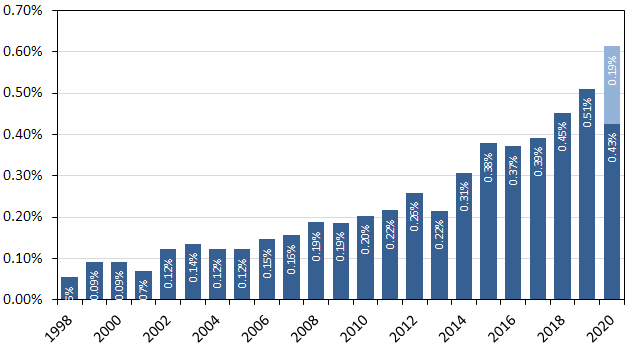Latest VAD jurisdiction report cards

Belgium and the USA state of Oregon both released their annual voluntary assisted dying (VAD) reports this week. I report on the numbers.
While the Netherlands and Washington state haven't released their 2020 annual VAD report cards yet, Belgium and Oregon have.
Belgium
Back in 2016 I wrote a detailed Whitepaper on assisted dying practice in Benelux, including data up to 2015. In it, I pointed out that in several years' time the trend to increasing rates of VAD would level off, like a sigmoidal (stretched-S shape) curve, as does most human adoption of new behaviours.
That time has arrived. The most recent data from both the Netherlands and Belgium shows that in both countries, the VAD rate, as a proportion of all deaths, has generally levelled off (Figure 1).
 Figure 1: VAD deaths as a proportion of all deaths in the Netherlands and Belgium
Figure 1: VAD deaths as a proportion of all deaths in the Netherlands and Belgium
Sources: Official Euthanasia Commission reports; Government total death statistics
The cultural rate of VAD in the Netherlands appears to be around 4.3% of all deaths, while in Belgium it's around 2.4%. No doubt these figures will vary slightly over coming years, but shrill pronouncements that the rate would continue to rocket higher and higher are refuted by the evidence.
That Belgium's “level” VAD rate is significantly lower than the Netherlands' despite quite similar (though not identical) laws, suggests that VAD rates are influenced more by cultural and other factors beyond the specific provisions of formal statutes and regulations.
Oregon
Meanwhile, in the state of Oregon, the Death With Dignity Act (DWDA) was revised in 2019. Previously, some people suffering intolerably at the very end of life were excluded from using the Act if they died within 15 days of deciding to use the Act. This was due to a fixed, mandatory 15-day cooling off period. Yet in the last weeks and months of life, an individual's condition can take a sudden and dramatic turn for the worse, so that previously the person may have not qualified for other reasons or felt they still had time to apply for access, and now would not qualify the 15 day cooling off period.
The cooling off provisions were updated by Oregon's legislature in 2019 to allow access without the cooling off period, in cases where the person is, in professional medical opinion — and with a formal declaration to the effect — reasonably likely to die before the 15 days had elapsed.
The revision was in effect for the entire 2020 calendar year.
As a consequence, some people felt they didn't need to apply quite so early “just in case” they might want to use the law, while others who would have been excluded altogether were able to use the law. This accounts for a slight dip in the “old” provisions rate, along with a rise in the total proportion of DWDA deaths (Figure 2).
 Figure 2: Oregon DWDA deaths as a proportion of all deaths, new-rule data in light blue
Figure 2: Oregon DWDA deaths as a proportion of all deaths, new-rule data in light blue
Source: Oregon DWDA annual reports; Government total death statistics
Oregon's overall rate of VAD remains much lower than in the Netherlands and Belgium, whose laws are not restricted to cases of terminal illness.
However, in no case has any parliament legislated to limit cases to a numbered cap. In all jurisdictions, legislation focuses on the conditions under which a person may become eligible to access VAD choice, regardless of the actual numbers requesting and qualifying for access.
